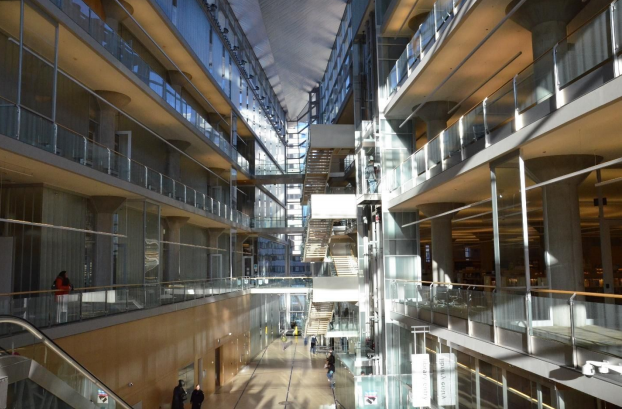- App Content
- App Content / News
- News
- News / Academics
- News / Politics And Administration
- News / Politics And Administration / Campus
Future architects gain experience off campus
Photo Courtesy of Merwick D'souza
A view of the Hennepin County library, Central Minneapolis.
February 13, 2017
In the first of week of February, architecture students from the College of Design returned from their designated trips for the spring semester. As part of the curriculum, second- and third-year students visited different locations around the United States.
Deborah Hauptmann, chair in the College of Design, underlined the intended purposes these trips serve. She emphasized the distinction between the theoretical aspects of architecture studied in the classroom and the significance of its application studied in the trips.
“As you can imagine, in architecture, they study history classes and theory classes,” Hauptmann said. “In the studio when they are designing a building, they don’t start from zero, they start by understanding the architecture that came before them. “What you can analyze in journals and print materials is one thing, but to be in the presence of that same work you’ve already analyzed is completely different.”
Hauptmann uses the “amazing” stairs in the oculi of Beardshear Hall as reference to underline the importance of experiencing architectural structure for an architect.
“There is no way on earth you can replace the feeling of walking up those stairs,” Hauptmann said.
The second-year architecture students had food and architecture as the theme of their travel. They were assigned with the task of observing how people interact with architectural spaces that host food.
“Our project is to design a food hub. And in order to do that, we had to experience the food culture of Minneapolis,” Merwick D’Souza, second-year architecture student, said.
Excluding the first year, which is the entry stage into the architecture program, the program runs through eight semesters that amount to four years of studio work. In their second year, students embark on these academic trips. Part of the goal of the trip for second-year students is to build peer relationships and team work.
“This is the moment you are building a sense of your class,” Hauptmann said. “Here are the people you are graduating with, so we do it also as a team-building exercise.”
Reminiscing about his first time going on a trip, Rami Mannan, third-year architecture student, said the trip deepened his understanding of where he stood as a future architect.
The department encourages students to first acquire a strong background about their immediate surrounding before traveling to other locations.
While some second- and third-year students travel to domestic locations, the fourth-year students usually travel internationally to places like Panama, Africa and Peru.
This geographical pattern of travel for architecture students is intentional because it is beneficial in terms of widening their horizons about different landscapes, building types and the environment, Hauptmann said.
Another key part of the travel is that students visit architecture firms in order to understand the demands of the working environment. The third-year students in New York went to firms like Bjarke Ingels Group, SHoP Architects and Tod Williams Billie Tsien Architects. In the process, they also got the opportunity to meet with potential employers.
“They were very useful,” Manna said. “They answered our questions in regard to future internships and job. I feel like I now know what to expect from firms.”
These trips tend to transcend academic purposes, as part of it also affects the character of the students, preparing and molding them for what’s to come.
“It gave me confidence, direction and a purpose,” Mannan said. “It will also help me prepare to compete with other fresh graduates.”
Hauptmann, who studied in the United States, travelled to Europe during her undergraduate studies for six months. During that that time, she experienced the benefits of having to be in the presence of different works.
“You can’t become someone who is sensitive to the environment without having an entire repertoire of experience to call on,” Hauptmann said. “You can become a mediocre architect but not one of any aspiration.”
















